Nature
The Betty Ann Sands (BAS) Memorial Healing & Artful Gardens at the Rose Haven Center of Healing offers visitors of all abilities opportunities for exercise, creative expression, skill building, socialization and most importantly, the chance to forge a vital connection and partnership with nature.
The Gardens as A Total Life Fitness Gymnasium
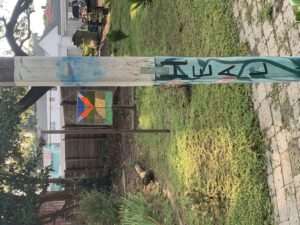
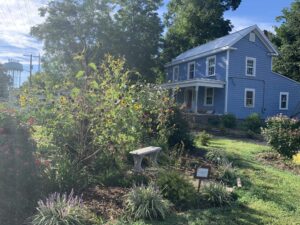
Many women Veterans suffer from trauma, or other negative experiences, while in the military. These experiences, along with gender-based social, economic, behavioral and institutional obstacles encountered after leaving the military can greatly increase stress and anxiety during reintegration into family and community life.
The BAS Memorial Gardens are a welcoming and safe space that can help minimize stress and anxiety while growing life fitness across mind, body, soul and through community. The landscape acts as a life fitness gymnasium, offering elements of horticultural and creative expressive therapy design to populations experiencing emotional, cognitive, social and even physical challenges. Horticultural therapy emphasizes plant/people interactions in various treatment, rehabilitation, or vocational programs while expressive arts therapy utilizes, “the innate human desire to create and channel though music, visual arts, poetry, dance, and other artistic forms in a variety of settings to channel self-expression and help people examine their body, feelings, emotions, and thought process.” This hybrid design enables Total Life Fitness skills through wellness and resilience-building activities.
At the Rose Haven Center of Healing, there is a purposeful and intended interface of the healing elements of nature, represented by a plant dominated landscape, mindfulness, and transcendence properties of features such as:
- A sensuous interaction, or lived experience with plants (planting, weeding or harvesting) and activities of creative self-expression filtered through all the human senses to also include memory and proprioception (how your brain understands where your body is in space). The “vividness” of time spent in, at and interacting with nature and self in a healing landscape.
- Kinetic movement through nature via accessible walkways, pathways and a garden labyrinth promoting playfulness, mindfulness, and physical exercise while defining boundaries of spaces, activity zones and displays. These elements focus attention and energies to components and displays within the plant environment, historical context and to infrastructure and sites of creative expression.
- Creative expression activities such as crafts and woodworking, in designated spaces out in the gardens or in the open-air barn.
- An abundance of interactions between plants and people that provide volunteer and more formal gardening opportunities offered in the organic raised bed produce garden as well as shrub and perennial beds throughout the healing landscape.
- Resting and sitting areas designed for individual reflection.
- A council ring and fire pit designed to promote community building for women Veterans involved in our Total Life Fitness programs, and other local Veteran or community groups interested in using it.
- Healing touchstone provides a physical, emotional, and transcendent sense of place important in healing.
- Subtle and occasionally overt use of metaphor is implicit in the healing blueprint to give those who visit a natural language to envision a journey of healing to themselves and others.
In addition, special events such as presentations, group tours, garden workdays, and occasional and regularly scheduled classes encouraging all aspects and benefits of the nature/human interface – including gardening, self and group expression, movement, and more to promote the many benefits the healing landscape offers to community members.
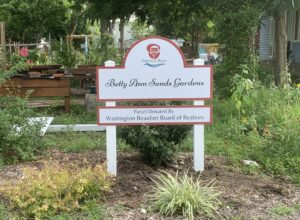
BAS Memorial Garden Features
See the inaugural Rose Haven Healing Gardens 2022 Calendar here
The Seed – Betty Wheeler Raised Bed Vegetable Garden
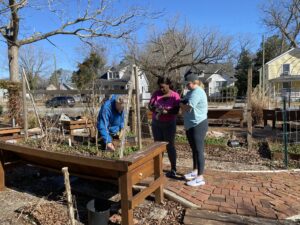
Eight raised beds, built by Lucas Wood for his Eagle Scout project, form the outside boundary of the walkway that encompasses the Betty Wheeler Raised Bed Garden. Labeled the “Seed” for its distinctive shape, the garden features a brick walkway and raised beds that allow opportunity for folks with all abilities to access, enjoy and get involved in informal or formal programs on gardening if so desired. In 2022, as Pamlico Rose Farms, we are expanding our growing capacity by piloting the Matsuda Chinampa, an ancient Aztec and Mayan mounding growing method.
The Eric and Patricia Sands Foundation Council Ring
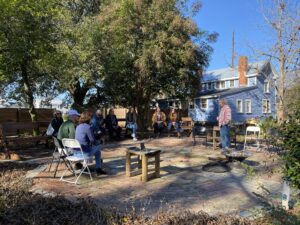
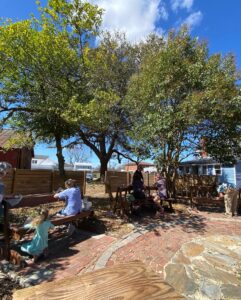
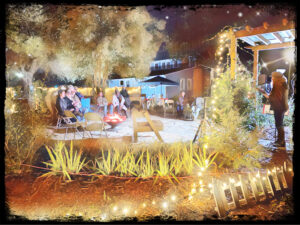
Our council ring serves several similar functions. It provides for social gatherings and group activities, it has hosted concerts, and has been instrumental in creating a safe and friendly environment for our retreat sessions. The addition of a fire pit adds both warmth and ambience to the council ring’s utility. Our 2021 Fall Concert in the Gardens with Laura Davis was performed in the council ring on a November evening with a roaring fire to provide equal parts warmth and ambience.
The Emily Carefoot Garden Labyrinth
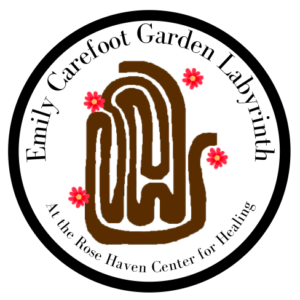
Another integrating element of our approach to wellness is our garden labyrinth (anticipated completion in the summer of 2022). A garden labyrinth is a circle composed of a continuous single pathway that winds to the center. Unlike a maze, the path is easily followed and once the path ends, you retrace your steps to the start. The concept and representation of a labyrinth stretches back to ancient Greece. The design of the labyrinth has been used by the Romans and the medieval and later Catholic churches to signify a greater harmony between life and the afterlife. The winding curves symbolized challenges of life, mindfully walking the path to its conclusion washed away those mortal challenges and opened up the next life. Garden labyrinths were built by early Scandinavians as part of life rituals. Today, garden labyrinths serve many uses. They may be used as a quiet oasis or other feature in the garden. Some users see them as symbols of life passages with rebirth or reincarnation as they are walking along. Others compare them to the annual journey of planets in the solar system. To many labyrinth users the paths provide personal, psychological or spiritual transformation. All we know is stepping on our labyrinth path in the company of flora and fauna can easily slow down mind and body to one long moment in time.
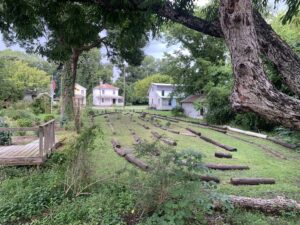
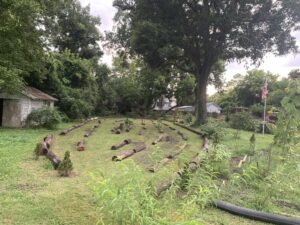
The Becky Hinsey Meditation Gardens Under the Tree of Life
Our most iconic symbol of who we are and what we do is the Tree of Life. Located in the back garden, the tree of life is a pecan tree felled by a hurricane in the last ten years. With part of the root ball still buried and functioning, the tree now grows horizontal, providing its canopy of summer green – resilient to adversity, bending, yet refusing to break. The main trunk of the close to a century old tree forms an archway into a meditation nook, offering a quiet space for reflection or a place for conversation with one or just a few.
The Greenhouse
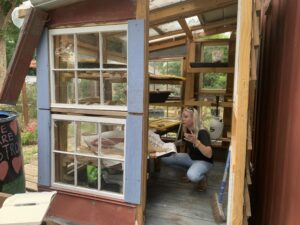
Constructed from reclaimed wood from the Haven House renovation and tin from the barn, the modest greenhouse serves multiple purposes, as the site of Pamlico Rose Farms Microgreens and as a seed starter for early spring planting
The Doc Matsuda Chinampa
Urban horticulture is not a fad. History is replete with sustainable urban agricultural production. The mounding growing approach developed during the time of the Aztecs south of Mexico City featured a series of raised mounds surrounded by canals and ditches in the shallow regions of lakes. Farmers use local vegetation and mud to construct chinampas. The canal water acts to irrigate the root system reducing the need for additional irrigation. The ancient urban horticulture approach can still translate today to wetlands and shallow areas of waterways. We are modeling a chinampa-like series of small mounds in the lowest point of elevation, and the wettest in the gardens.
About the Design Team
PRI Executive Director, and anthropologist, Robert Greene Sands conceptualized the healing landscape to be integral component of the Rose Haven Center of Healing. He worked with landscape architect Rich Pracopcyx on the initial gardens design in 2018 when the space was adjacent empty lots wildly overgrown from years of neglect. Sands’ career included seven years working in cultural and historic preservation and he applied the sense and importance of “place” to the healing landscape where nature, creative expression, movement and community intersect in distinct yet connected areas of the gardens.
From his anthropology, Rob saw the design and development/construction of the gardens lending itself to the power of metaphor, especially poignant to the community of women Veterans, many struggling with the effects of trauma who will spend time in the gardens. Since that initial design, Sands, with the help of an all-volunteer garden crew that still features crew members from three years ago at the start of development, worked daily for two years, toiling in the dirt, re-designing and adapting the gardens to meet a dynamic mission and recorded that evolution in ample imagery. Many of those images have been included in Facebook posts.
The Garden Map
Our Rose Haven Center of Healing as a concept and a place is still evolving week to week, month to month and season to season since the inception of the Gardens in Fall of 2018. The change over time has been both dramatic and subtle. The events and activities hosted in the gardens so far, socials, art exhibits, and our first concert in November, not left unmentioned, our summer vegetable harvests from our raised beds produce garden, promise a near and long-term utility of the healing gardens to our mission and the Washington community. As the Haven House, then the renovation of our barn into a community center come online, the synergy between the three Center components will indeed represent a most unique and innovative approach to healing for women Veterans and others. At some point, we had to “map a line in the sand” and provide a geographical narrative of places and spaces in the gardens. To do this, we enlisted the amazing skills of Coralie Milnes, a former summer intern at Rose Haven, to create a garden map. We are ecstatic with her effort and proudly present our 2022 Betty Ann Sands Healing and Artful Gardens Cultural Map that reflects the importance of nature and creative expression to healing.
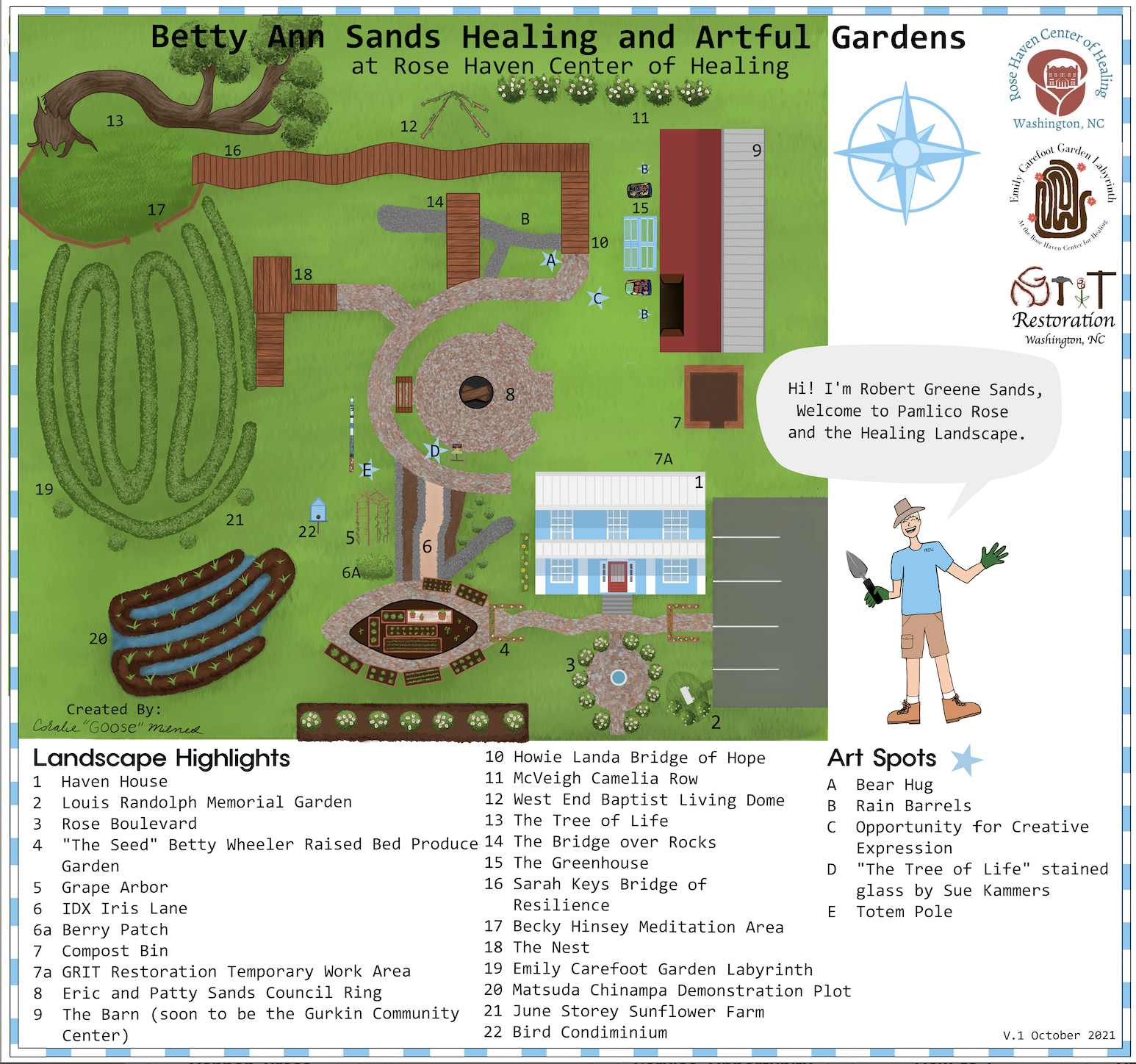
Enjoy our beautiful garden calendar!
